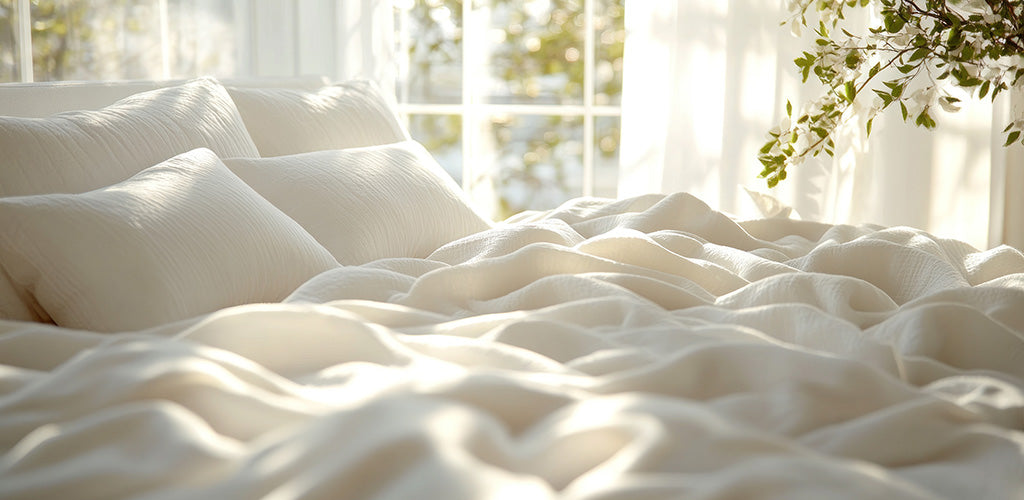
The ideal sleeping environment
Restful sleep is more than just resting – it's a fundamental component of our health and quality of life. However, how well we actually sleep depends not only on the duration of sleep, but also on the conditions in which we sleep. Our environment plays a key role: Light, sounds, temperature, order, and even smells influence our sleep more than we often realize. In this article, we'll show you how to optimize your sleeping environment – for deeper rest, faster recovery, and greater well-being during the day.
Table of contents
- Proper sleep hygiene
- How to turn your bedroom into a feel-good oasis
- Quick tips for the perfect sleeping environment
- The ideal sleeping environment for children
- Conclusion
1. Proper sleep hygiene
Before you design your bedroom, it is worth taking a look at your bedtime habits. This so-called Sleep hygiene forms the foundation for good sleep. Even the most beautiful surroundings are of little use if your daily rhythm is out of balance.
A regular Sleep-wake rhythm is essential. Try to go to bed and get up at the same time every day – even on weekends. Your body loves routine, and a consistent structure helps him to relax and regenerate.
Evening rituals also play a big role. A warm bath, a good book or a cup of calming herbal tea can help you end the day gently. It's important that you consciously take time for yourself and set clear boundaries between day and night.
Also, if possible, avoid caffeinated Drinks or heavy Eat in the hours before bedtime. alcohol may make it easier to fall asleep in the short term, but it has been proven to disrupt sleep quality – especially in the second half of the night. digital media How
2. How to turn your bedroom into a feel-good oasis
Order, colors and atmosphere
Your bedroom should be a place of peace and comfort. A tidy, harmonious environment has a positive effect on your mind – because external clutter often also creates inner unrest. Keep distractions to a minimum: no work documents, no piles of laundry, no cluttered shelves. The clearer and more tranquil the room is, the better your body can switch off.
Also pay attention to the color scheme. Soft, natural tones such as light gray, beige, blue, or sage create a relaxed atmosphere. Intense colors such as red or neon colors should be avoided, as they can have an activating effect. Natural materials and calming elements such as plants or linen-look fabrics complete the picture. Plants such as lavender or aloe vera, in particular, provide Fragrances additionally for a pleasant and relaxing room climate.
The right sleeping equipment
Good sleep begins in bed – more precisely with the right mattress, a suitable Pillow and more breathable bed linenA mattress should be tailored to your body weight, sleeping position, and individual needs. Side sleepers need more support in the hips and shoulders, while back sleepers need good lumbar support.The pillow should also support your neck posture – because Tensions in the morning are often a sign of an incorrect lying position.
When it comes to bedding, natural, temperature-regulating materials like cotton, linen, or Tencel are a good choice. They ensure a comfortable sleeping environment—not too warm, not too cold. You should also choose your duvet according to the season: light and airy in summer, fluffy and warm in winter.
3. Quick tips for the perfect sleeping environment
In addition to sleep hygiene and bedding, there are many small but effective measures you can take to noticeably improve your sleep quality. Here's an overview of the most important tips.
Tip #1: Keep an eye on the room temperature
The ideal sleeping temperature is between 16 and 18 degrees Celsius. Sounds cool? But it's exactly right. Your body lowers its core temperature to enter sleep mode – a cool room temperature supports this process. In summer, light blankets or a fan help; in winter, a short burst of ventilation in the evening is often enough. Important: Avoid overheated rooms, which can cause dry mucous membranes and restless sleep.
Tip #2: Use light purposefully
Light controls your biological rhythm – so take advantage of it. During the day, you should spend as much time as possible in natural daylight to stabilize your biorhythm. In the evening, however, the light should be warm, soft, and as dim as possible. Bright ceiling lights or LED spotlights have an activating effect and can Fall asleep complicate.
Use curtains or blinds to completely darken your bedroom. If you need light to wake up, a sunrise alarm clock is a good solution—it simulates sunrise and helps you wake up gently.

Tip #3: Block out noise
Even quiet, regular noises can disturb your sleep – especially during deep sleep phases. If you live near a busy street or are sensitive to noise, earplugs or so-called White noise-Devices that produce consistent noises and mask other sounds. Alternatively, you can also use soothing Nature music or meditation sounds.
Tip #4: Improve indoor air quality
Fresh air works wonders: Regularly airing your room before bedtime supplies your body with oxygen and reduces the CO₂ concentration in the room. Plants like snake plants, spider plants, and ivy are ideal bedroom inhabitants because they filter the air and provide oxygen—all without using electricity.
In dry winter air, a humidifier can help make the room climate more pleasant. If you prefer to avoid technology, simply place a bowl of water on the heater. A drop of essential oil (e.g., lavender) will also help. B. lavender) in the diffuser ensuresüthe relaxed atmosphere – but please use sparingly.
Tip #5: Digital Detox – no room for technology
Tip #6: Promote mental relaxation
Sometimes the problem with falling asleep isn't physical, but rather mental. Overthinking, to-do lists, or worries can rob us of sleep. In such cases, simple relaxation exercises can help: Breathing techniques, gentle stretches or a short guided meditation before falling asleep can calm the flow of thoughts. Writing down thoughts or tasks can also help clear your head – try a notebook next to the bed.
4. The ideal sleeping environment for children
Also Children benefit enormously from a lovingly designed and sleep-friendly environment. A regular evening routine is especially important here: Set bedtimes, recurring rituals like reading aloud or cuddling together help children feel safe and secure. This way, the child's body learns when it's time to sleep.
The nursery itself should be quiet, well-ventilated, and free of unnecessary stimuli. Too many toys or bright lights are more distracting than calming. A small night light in a warm tone can help alleviate anxiety without disturbing sleep.
Safety is also important: Babies Children and toddlers should avoid loose blankets, pillows, or stuffed animals in bed. Also, make sure you have the right mattress—not too soft, but comfortable—and a pleasant room temperature. A soft sleeping bag replaces the blanket and gives your child an additional sense of security.
5. Conclusion
- Sleep hygiene first: A regular rhythm, evening rituals and conscious avoidance of stimulants promote restful sleep.
- The bedroom as a retreat: Order, soft colors and a conscious approach to interior design create a calming atmosphere.
- The right equipment makes the difference: A suitable mattress, breathable bed linen and individually tailored pillows provide optimal support for the body.
- Optimize room climate, light and noise: Fresh air, darkness, pleasant temperature and silence are the best companions for sleep.
- Digital Detox & Relaxation: No cell phone in the bedroom – instead, prefer mental peace through mindfulness and conscious relaxation techniques.
Your bedroom is more than just a room with a bed—it's your personal retreat. Design it to truly help your body and mind rest.


Leave a comment
This site is protected by hCaptcha and the hCaptcha Privacy Policy and Terms of Service apply.